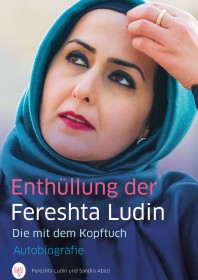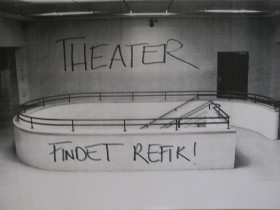A Conversation with Fereshta Ludin about the Headscarf Debate, Discrimination, and Her Hopes for the Future.
To win the right to work as a teacher in the classroom while wearing her headscarf, Fereshta Ludin had to go all the way to the German Supreme Court (see below). On 17 September 2015, she will join us as part of the series “New German Stories” to introduce her book Enthüllung der Fereshta Ludin. Die mit dem Kopftuch (“The Unveiling of Fereshta Ludin: The One with the Headscarf”). Rafiqa Younes and Julia Jürgens spoke with her in the lead-up to the event.

Book cover © Deutscher Levante Verlag
Ms. Ludin, did you ever guess that the first lawsuit you filed against your employers, in 1998 when you were 25 years old, would set off a nationwide debate about the headscarf ban?
You can’t really imagine something like that. I was still very young and idealistic. I wanted to work as a teacher and had no intention of provoking the public or any politicians.
From your perspective, was it worth it to go all that way through courts, becoming, as you did, a public figure – “the one with the headscarf” as the title of your book ironically references?
I don’t regret a single step along the way. I would have regretted much more, to have had to endure the injustice. I took an active stand against discrimination by going through the courts. Many other women were also affected. It was never my aim to become a public person. → continue reading
We’d like to let you know about a very special documentary screening at Kino Babylon Mitte, Berlin, on 25 August: L’chaim! To life!
The film portraits Chaim Lubelski, an orthodox Jew and successful businessman in New York who jet-sets to St. Tropez. When his mother, a Holocaust survivor, is in need of care, he returns to Antwerp to look after her.
Trailer
In his feature-film debut, producer and director Elkan Spiller presents his cousin, Chaim, as a rebellious, charming maverick – a man who tries to relieve his parents’ pain with courage, humor and love. → continue reading

A scene from the theater play, “Findet Refik!” © Lernkultur – Institut für Bildungsforschung und Evaluation, photo: Katharina Obens
The recently approved introduction of upper secondary level teaching at the Refik-Veseli-School was a first for Kreuzberg 36, an inner-city district of Berlin, which is very popular. Now, local kids from the neighborhood called “Wrangelkiez” need no longer travel to other districts to study for the “Abitur,” Germany’s high school diploma. This is a major step towards assuring non-segregated educational opportunities in Kreuzberg
The 8th Integrated High School in the downtown district of Kreuzberg-Berlin sealed its partnership with the Jewish Museum Berlin in June 2012. Prior to that, all the staff and pupils had voted on a new name for their school and decided to call it the Refik-Veseli-School. For during a study trip to Israel, pupils had visited the Yad Vashem Museum and learned about the history of Refik Veseli—a man acknowledged being Righteous Among the Nations.
Refik Veseli was a 17-year-old apprentice in a photo studio in Tirana, Albania, when he first met the Jewish photographer Mosche Mandil, who had fled Yugoslavia to escape the National Socialists. But in 1943 the Germans invaded Albania too, and things became much more dangerous for Jews. The Veseli family owned a house in Kruje and decided to hide Mosche Mandil and his family there. It turned out to be a three-year commitment. → continue reading

